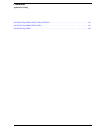
42 Chapter 1
Programming Fundamentals
Parameters in Commands
Parameters in Commands
There are four basic types of parameters: boolean, key words, variables and
arbitrary block program data.
Boolean
The expression OFF|ON|0|1 is a two state boolean-type parameter. The numeric
value 0 is equivalent to OFF. Any numeric value other than 0 is equivalent to ON.
The numeric values of 0 or 1 are commonly used in the command instead of OFF
or ON, and queries of the parameter always return a numeric value of 0 or 1.
Key Word
The parameter key words that are allowed for a particular command are defined in
the command description and are separated with a vertical slash.
Units
Numerical variables may include units. The valid units for a command depends on
the variable type being used. See the following variable descriptions. If no units are
sent, the indicated default units will be used. Units can follow the numerical value
with, or without, a space.
Variable
A variable can be entered in exponential format as well as standard numeric
format. The appropriate variable range and its optional units are defined in the
command description.
In addition to these values, the following key words may also be used in commands
where they are applicable.
MINimum - sets the parameter to the smallest possible value.
MAXimum - sets the parameter to the largest possible value.
UP - increments the parameter.
DOWN- decrements the parameter.
Include the key word MINimum or MAXimum after the question mark in a query
in order to return the numeric value of the key word.
Example query: [:SENSE]:FREQuency:CENTer? MAXimum
Variable Parameters
<ampl>,
<rel_ampl> The <ampl> (amplitude) parameter and the <rel_ampl> (relative
amplitude) parameter consist of a rational number followed by
optional units. Acceptable units for <ampl> include: V, mV, µV,
dBm, dBmV, dBµV, Watts, W. <rel_ampl> units are given in dB.


















